
|
|
|
|
Archived News Map Sensors – What's the Pressure!
The MAP sensor (Manifold Absolute Pressure) is an ECU input sensor that has been around for a long time. These sensors are generally used in a “Speed / Density” or “Manifold Pressure Controlled” engine management system that does not use an Airflow / Mass Sensor. Purpose and Function
The MAP sensor piezo–resistive circuit produces a linear analogue voltage proportional to manifold pressure. This allows the air mass to be precisely defined. This information is processed by the engine management ECU and is used to control fuel delivery, and in most cases, ignition timing. Where is the MAP Sensor? Many of the earlier vehicles used a MAP sensor mounted on the firewall or similar, connected to the manifold via a vacuum hose. To reduce the effects of vacuum leaks on MAP sensor operation, due to the deterioration of these vacuum hoses, the current trend is to mount the MAP sensor directly on to the manifold thus eliminating any vacuum hose problems. Some foreign manufacturers integrate the MAP sensor with the ECU to eliminate any further electrical connection problems but a vacuum hose is still the link between the inlet manifold vacuum and the integral MAP sensor. This now creates a potential build up of oil fumes from the engine directly into the ECU, especially on high kilometre vehicles. Let’s Raise the Bar
A normally aspirated engine would not require a MAP sensor rated at more than 1.0 Bar. If however, a MAP sensor is used on a Turbo charged engine when manifold pressure reaches higher that 1.0 Bar Atmospheric Pressure, then a 2.0 Bar or higher is required depending on the boost pressure developed. For example a turbo charged engine with a 0.5 Bar (That’s right, half a bar!) boost would require a 2.0 Bar MAP sensor. Be Aware MAP sensors may look the same but do not necessarily work the same. If you have to replace a MAP sensor, ensure your requirements are crystal clear when ordering. There are specific numbers stamped on most MAP sensors to identify weather it was a 1.0 Bar or greater rating. How do you know if a MAP sensor is faulty? There are so many external factors that can affect the operation of the MAP sensor. It is important that tests are carried out to ensure the MAP sensor is not replaced unnecessarily. Mechanical Faults - For example
Many other faults may be successfully diagnosed using test equipment such as vacuum gauges and smoke generating machines. Electrical Faults
Why do some MAP Sensors have 4 Terminals? A MAP sensor generally requires three terminals to complete its electrical circuit to generate a signal.
Why have a MAP Sensor and a Mass Air Flow (MAF) Sensor together on the one engine?
General Precaution Even though the MAP sensor is fairly robust in construction, severe engine backfiring can create internal unrepairable damage to a new unit. It is important to ensure the cause of such a condition has been identified and dealt with. |
Archived News
Understanding EGR Systems (Pt 1) |
| privacy statement terms of use terms and conditions sitemap news |  |




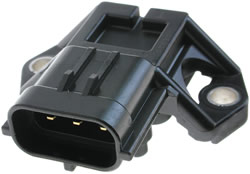 MAP Sensors are used to measure inlet manifold pressure to give an indication of engine load. This is achieved by measuring absolute pressure in the inlet manifold and comparing it with a reference vacuum, not with the ambient pressure.
MAP Sensors are used to measure inlet manifold pressure to give an indication of engine load. This is achieved by measuring absolute pressure in the inlet manifold and comparing it with a reference vacuum, not with the ambient pressure. 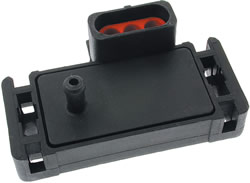 As mentioned previously the MAP sensor measures “absolute” pressure, not gauge pressure so normal atmospheric pressure (at sea level) is 14.7 PSI or 1.0 Bar.
As mentioned previously the MAP sensor measures “absolute” pressure, not gauge pressure so normal atmospheric pressure (at sea level) is 14.7 PSI or 1.0 Bar.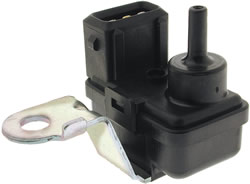 The voltage or frequency output signal supplied by the MAP sensor to the ECU must be stable and correctly represent the manifold vacuum. Any MAP sensor circuit ground / earth and reference volt deficiencies will affect the output signal to the ECU causing incorrect fuel delivery and ignition timing. Correct manufacturers testing procedures would ensure misdiagnosis is prevented.
The voltage or frequency output signal supplied by the MAP sensor to the ECU must be stable and correctly represent the manifold vacuum. Any MAP sensor circuit ground / earth and reference volt deficiencies will affect the output signal to the ECU causing incorrect fuel delivery and ignition timing. Correct manufacturers testing procedures would ensure misdiagnosis is prevented.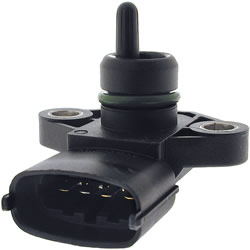 Many later and current vehicles use what is known as a “T – MAP” sensor mounted directly on the engine intake manifold and can be identified by having a four terminal pin connector. This unit now integrates the Intake Air Temperature (IAT) sensor which operates independently of the MAP sensor and utilises the fourth terminal pin.
Many later and current vehicles use what is known as a “T – MAP” sensor mounted directly on the engine intake manifold and can be identified by having a four terminal pin connector. This unit now integrates the Intake Air Temperature (IAT) sensor which operates independently of the MAP sensor and utilises the fourth terminal pin.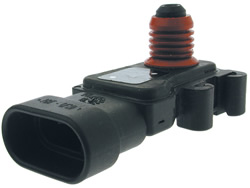 With OBDII standards, vehicle manufacturers are required to test their EGR valve function during driving conditions. Some manufacturers use a Mass Air Flow sensor for the primary load sensor. They also utilise a MAP sensor for rationality checks and to test the EGR valve. How? During Deceleration that’s how –That is when low absolute pressure (High Vacuum) in the inlet manifold, may cause the ECU (under certain conditions) to open the EGR valve and monitors the MAP sensors values. If the EGR valve is functionally correctly, the manifold absolute pressure will increase as exhaust gasses enter the inlet manifold.
With OBDII standards, vehicle manufacturers are required to test their EGR valve function during driving conditions. Some manufacturers use a Mass Air Flow sensor for the primary load sensor. They also utilise a MAP sensor for rationality checks and to test the EGR valve. How? During Deceleration that’s how –That is when low absolute pressure (High Vacuum) in the inlet manifold, may cause the ECU (under certain conditions) to open the EGR valve and monitors the MAP sensors values. If the EGR valve is functionally correctly, the manifold absolute pressure will increase as exhaust gasses enter the inlet manifold.